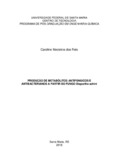| dc.creator | Reis, Caroline Medeiros dos | |
| dc.date.accessioned | 2019-10-31T20:46:10Z | |
| dc.date.available | 2019-10-31T20:46:10Z | |
| dc.date.issued | 2018-08-23 | |
| dc.identifier.uri | http://repositorio.ufsm.br/handle/1/18735 | |
| dc.description.abstract | Due to the emergence of resistance to the drugs used to treat diseases caused by fungi and bacteria, there is a growing need to identify new compounds that can be used in medicines. The compounds produced by endophytic fungi are a promising source in the production of metabolites with antifungal and antibacterial action. Thus, the objective of this work was the production of metabolites from the submerged fermentation of the fungus Diaporthe schini, evaluation of the in vitro antibacterial and antifungal activity of the extract from the fermentation and separation and characterization of these metabolites. Among the microorganisms tested, the extracts had a greater inhibitory action on the gram-positive bacteria Staphylococcus epidermidis and the gram-negative Enterobacter aerogenes and Klebsiella pneumoniae and on the fungus Candida krusei. The extract from the hexane extraction was separated into fractions by column chromatography and the main biologically active substances characterized by GC-MS were: 13-Docosenamide, (Z); 2-Hexadecene, 3,7,11,15-tetramethyl; 9-Octadecenamide and 11-Octadecenoic acid, methyl ester. Until now, there is no reports on literature related to the identification of antibacterial and antifungal metabolites produced by submerged fermentation of Diaporthe schini. This work is an initial study where the conditions of the process can be optimized through of the production of a specific compound and can be a promising source for new drugs. | eng |
| dc.description.sponsorship | Conselho Nacional de Pesquisa e Desenvolvimento Científico e Tecnológico - CNPq | por |
| dc.language | por | por |
| dc.publisher | Universidade Federal de Santa Maria | por |
| dc.rights | Attribution-NonCommercial-NoDerivatives 4.0 International | * |
| dc.rights.uri | http://creativecommons.org/licenses/by-nc-nd/4.0/ | * |
| dc.subject | Fermentação submersa | por |
| dc.subject | Diaporthe schini | por |
| dc.subject | Antifúngico | por |
| dc.subject | Antibacteriano | por |
| dc.subject | Submerged fermentation | eng |
| dc.subject | Diaporthe schini | eng |
| dc.subject | Antifungal | eng |
| dc.subject | Antibacterial | eng |
| dc.title | Produção de metabólitos antifúngicos e antibacterianos a partir do fungo Diaporthe schini | por |
| dc.title.alternative | Production of antifungal and antibacterial metabolites from Diaporthe Schini | eng |
| dc.type | Dissertação | por |
| dc.description.resumo | Devido ao surgimento de resistência aos medicamentos usados no tratamento de doenças causadas por fungos e por bactérias, há uma necessidade crescente da identificação de novos compostos que possam ser utilizados em medicamentos. Os compostos produzidos por fungos endófitos são uma fonte promissora na produção de metabólitos com ação antifúngica e antibacteriana. Dessa forma, o objetivo desse trabalho foi a produção de metabólitos a partir de fermentação submersa do fungo Diaporthe schini, avaliação da atividade antibacteriana e antifúngica in vitro do extrato proveniente da fermentação, separação e caracterização desses metabólitos. Dentre os microrganismos testados, os extratos apresentaram maior ação inibitória sobre a bactéria gram-positiva Staphylococcus epidermidis e as gram-negativas Enterobacter aerogenes e Klebsiella pneumoniae e sobre o fungo Candida krusei. O extrato proveniente da extração com hexano foi separado em frações por cromatografia em coluna e as principais substâncias com efeito biológico caracterizadas por GC-MS foram: 13-Docosenamide, (Z); 2-Hexadecene, 3,7,11,15-tetramethyl; 9- Octadecenamide e 11-Octadecenoic acid, methyl ester. Até o presente momento não se tem relatos da literatura relacionados a identificação de metabólitos antibacterianos e antifúngicos produzidos por fermentação submersa de Diaporthe schini. Este trabalho é um estudo inicial onde as condições do processo podem ser otimizadas buscando a produção de um composto em específico, podendo ser uma fonte promissora para a obtenção de novos medicamentos. | por |
| dc.contributor.advisor1 | Kuhn, Raquel Cristine | |
| dc.contributor.advisor1Lattes | http://lattes.cnpq.br/1479407050883691 | por |
| dc.contributor.advisor-co1 | Jahn, Sérgio Luiz | |
| dc.contributor.advisor-co1Lattes | http://lattes.cnpq.br/7735147410610776 | por |
| dc.contributor.referee1 | Terra, Lisiane de Marsillac | |
| dc.contributor.referee1Lattes | http://lattes.cnpq.br/3695292052760336 | por |
| dc.contributor.referee2 | Prá, Valéria Dal | |
| dc.contributor.referee2Lattes | http://lattes.cnpq.br/1873977455804734 | por |
| dc.creator.Lattes | http://lattes.cnpq.br/8915760164601145 | por |
| dc.publisher.country | Brasil | por |
| dc.publisher.department | Engenharia Química | por |
| dc.publisher.initials | UFSM | por |
| dc.publisher.program | Programa de Pós-Graduação em Engenharia Química | por |
| dc.subject.cnpq | CNPQ::ENGENHARIAS::ENGENHARIA QUIMICA | por |
| dc.publisher.unidade | Centro de Tecnologia | por |



